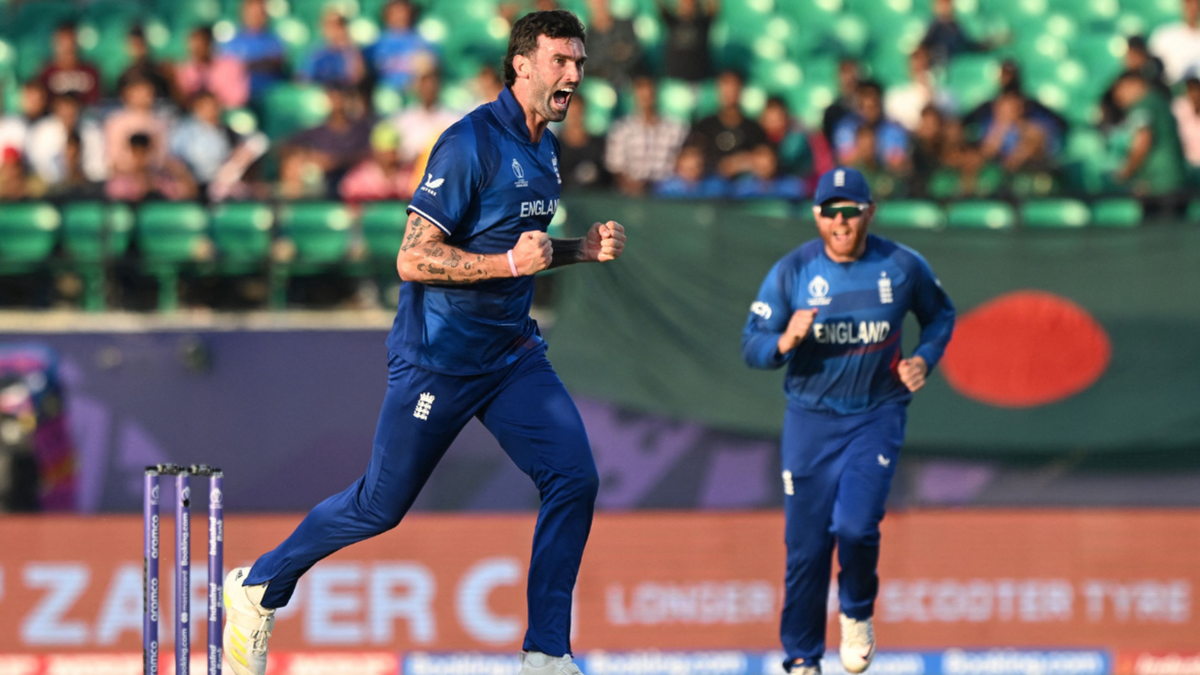
The ball Reece Topley produced to bowl Shakib Al Hasan in Dharamsala was as perfect as it gets.
To bet on the World Cup with our Match Centre Partners bet365 head here.
Pitching on off stump, drawing Shakib forward and out of his crease before flicking the off bail. “That’s where you want it,” Topley said of the delivery after the match. “The wind was coming over my left shoulder, I had a really good ball… I thought today’s going to be a good day for me. Sometimes you just get that feeling.”
By the time he’d bowled Shakib in the sixth over of England’s innings, it had already been a good day for Topley. He’d struck with his fourth ball of the game, taking advantage of the early swing and finding Tanzid Hasan’s outside edge, before finding himself on a hat-trick two balls later, having also dismissed Najmul Hossain Shanto.
Despite finishing as the pick of the bowlers with 4-43 on his World Cup debut, according to Topley, that performance was a starting point rather than his ceiling value. “I’m sort of undercooked,” he said. “Hopefully, I’ll peak at the right time. I haven’t played a lot of cricket this summer, I’ve been wrapped up in cotton wool, so thanks to everyone that I’ve made it here.”
It’s worth remembering the journey Topley’s been on to reach this World Cup. He was first picked for England as a 21-year-old and has been in their white-ball plans for almost a decade. But long periods out with injury, including missing the T20 World Cup last year, meant he’s still one short of fifty international caps. So numerous were his injury setbacks that he considered quitting the sport at multiple points.
But, in India, undercooked or not, seeing the devastating impact Topley immediately had when given a chance, it seemed even more of an oversight that he wasn’t picked for England’s tournament opener against New Zealand.
Since the beginning of 2022, Topley has taken more wickets than any of England’s other left-arm pacers. He’s done so at a lower average, economy and strike rate than any other. In every innings Topley has bowled in during that time, he’s been used as an opening bowler to take advantage of the early swing and bounce from the appreciable height he releases the ball. His role in the attack is clearly defined.
An incredible spell of bowling from Reece Topley today 💥#CWC2023 #ENGvsBAN pic.twitter.com/wv6AcEi5m0
— Wisden (@WisdenCricket) October 10, 2023
However, at Ahmedabad in England’s disastrous tournament opener against New Zealand, they opted to go with Sam Curran over Topley as their new ball left-armer. It was a decision which appeared as much based on their batting anxieties as what their best bowling attack was. With Moeen Ali playing as the second spinner and Curran in at No.8 above Chis Woakes, any potential collapse was theoretically mitigated by the potential of lower-order runs. But while England did indeed require those tail-end runs against New Zealand, they had bigger problems with the ball.
After an impressive opening couple of overs from Curran, he, along with Mark Wood quickly fell victim to the Rachin Ravindra show. It was only the fourth time Curran had been used as an opening bowler in ODIs in the last two years. In all three matches he played in England’s pre-tournament preparation series against New Zealand, he came on to bowl after the powerplay once the specialist new-ball left-armers had bowled their opening spells.
Yesterday in Dharamsala, he was once again kept back until after the powerplay. The chopping and changing of his role, despite being part of England’s first-choice World Cup XI, is a clear sign that they’re still working out how best to use him and that they’re still scrambling to find their best combination. Curran has been embedded into the mainstream ODI side thanks to his effectiveness at the death in T20Is, in the hope that he could have a similar effect as he did during last year’s T20 World Cup. While this is perfectly viable, and he was effective in that role in Bangladesh earlier this year, the fundamental differences between ODI and T20 bowling must be acknowledged.
Curran is most effective in T20s at the points in the game where the batters are looking to score the quickest, at ten runs an over or more. In ODIs, when batters are content to ease him for five or six runs an over at the start and in the middle, it’s understandable that he’s less effective.
In 2019, England had a well laid out approach to their pace attack. Woakes and Jofra Archer would bowl the opening burst before Liam Plunkett and Mark Wood took over in the middle. Having struggled to replace Plunkett’s role in the intervening years and with both Woakes and Wood spending long spells on the sidelines with injuries, their attack this time around is far less well crafted.
But, in Topley, England have a readymade and devastating new-ball powerhouse. The full force of his devastation was felt against India last year, when he took six wickets in a brilliant spell which blew away India’s top order. He dismissed Rohit Sharma for a duck and ripped through Shikhar Dhawan and Suryakumar Yadav. That kind of spell is something England’s other left-armers, Curran and David Willey, just aren’t capable of.
Left-arm pacers are the lynchpin of several of the best bowling attacks in this World Cup. Mitchell Starc, Shaheen Shah Afridi and Trent Boult were all pre-tournament picks for the leading wicket-taker trophy at the end of the tournament.
Topley’s spell at Dharamsala showed that England have their own weapon in that regard, if only they’d remember to pick him.








